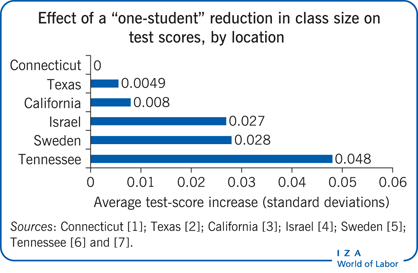Elevator pitch
Numerous economic studies have considered the relationship between class size and student achievement, the majority of which have focused on elementary schools in the US and Europe. While the general finding is that smaller classes are associated with increased student achievement, a few high-quality studies find no relationship. Further, empirical research on the costs and benefits of smaller classes concludes that other education policies, such as tutoring, early childhood programs, or improving teacher quality would be better investments.
Key findings
Pros
In general, smaller classes are associated with increased student achievement, usually measured by standardized tests in multiple subjects such as mathematics and reading.
There are benefits of smaller class sizes when variation in class size (due to maximum class-size rules) and random fluctuations in population are taken into consideration.
The positive relationship between smaller class size and student achievement holds for students in different grades as well as in different countries and across continents.
Reducing class size is a clear education policy that is popular with students, parents, teachers, and policymakers, and hence easy to argue for.
Cons
Several high-quality studies find no relationship between class size and student achievement.
Reducing class size is a very expensive policy reform relative to other reforms, which may also provide better value.
Because most studies focus on elementary schools, much less is known about the relationship between class size and student achievement in secondary schools.
Reducing class size in many schools in developing countries is unlikely to improve achievement as these schools have more fundamental challenges, such as high teacher absenteeism.
